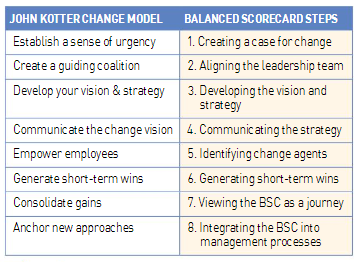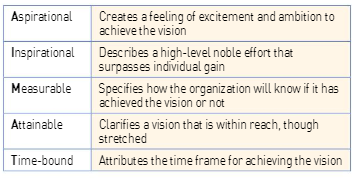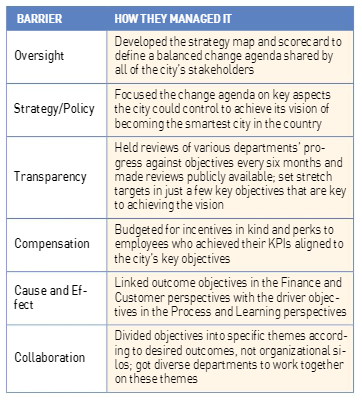Practical steps to make change stick

The oxymoronic “change-is-the-only-constant” is heard everywhere in corporate corridors, yet change is ever elusive. A Google search on the very term “change management” turned up 21,600,000 results – that’s twenty-one million citations.
Annual HR allocation of budgets for driving change is by no means small. Yet, very few organizations have done strategic change management well for a variety of reasons including lack of commitment of the top leadership, alignment, training that is superficial, but most importantly, the inability to execute the change agenda.
It is well documented that 9 out of 10 organizations fail to execute their well-crafted strategies. Our research and work with organizations over the past two decades clearly show the following fundamental issues for the execution fiasco:
- There is no commonly accepted way to describe change strategy and most companies do not know how to translate it well to operational terms.
- 95 percent of employees do not understand strategy. How do you expect them to do what the top management wants done?
- 60 percent of organizations do not link budgets with strategy. While a new change strategy may require new initiatives, budgeting has always been an aggregation of projections from existing initiatives or businesses.
- 75 percent of management does not have incentives linked to organization strategy.
- 85 percent of managers spend less than one hour per month discussing strategy.
Most of the reviews tend to move around operational issues and chasing the ever-elusive targets.
Strong leadership is essential to the success of any change effort. Imagine the performance of General Electric without the leadership of Jack Welch, although we know now that would not suit today’s times. Think of what Microsoft would look like, if not for Nadella’s organizational skill and strategic vision. Even Indian cricket team is unlikely to excel without someone like a powerful captain Kohli. If your organization has used Kaplan and Norton’s Balanced Scorecard the right way – not just as a performance measurement system – you will have realized its power to drive change. The first step to driving change in order to build a strategy-focused organization is to mobilize change through aligning senior leadership.
The BSC can be made an effective leadership tool for managing change. What you need to do is adapt the right processes for it. The most popular and powerful 8-step Leading Change framework of John Kotter can be mapped with BSC steps to drive serious strategic change as shown below:

Even if you don’t have a basic BSC, you can still build one quickly for the strategic change agenda you desire in a simple three-phase plan that we call as Refresh, Change and Sustain. The first three BSC steps fall into Refresh, the next two in Change and the last three into Sustain.
Refresh Phase
To convince your organization that BSC is a powerful tool for driving strategic change, visualise where the organization is today and where it should ideally be in the future, and emphasize the chasm to be bridged. In this phase, you must revisit and validate your enterprise vision, do a SWOT analysis, align the leadership team by getting them to agree on vision plus the strategy to achieve it and by getting their commitment to the process, and finally getting them to develop the new vision and strategy. Steps 1-3 define this phase.
Step 1: Create a case for change
Craft a consistent, memorable story about where your organization has been by asking:
- “What is our mission – why do we exist? Is that still valid?”
- “What are our greatest accomplishments? How do these support the overall mission and vision?”
- “In what ways have we fallen short in achieving our vision?”
Our client, a telco, started off with a series of strategy workshops for senior leaders. In preparation for these workshops, we asked participants to assess the effectiveness of their current vision. 73% responded that the vision was 90% on target with the current direction.
Though only a minority felt it was off-target, the executive leaders decided to address their concern. Why? A significant minority, if ignored, can jeopardise any strategic change execution.
Based on the suggestions for improvement that included focussing less on short-term reactions to market and more on purpose, and simplifying vision statement, the team arrived at a concise, purpose-driven vision:
“Be the most cost-effective and innovative telecom infrastructure company in the world in the next 7 years.”
Once the assessment of as-is is done, evaluate the current Strengths and Weaknesses (internal attributes) and Opportunities and Threats (external attributes), and map it to the familiar four BSC perspectives: Financial, Customer, Internal Process and, Learning and Growth. For a detailed questionnaire to accomplish this, you may contact me.
Step 2: Align the leadership team
Building consensus and commitment are critical for a successful execution of change agenda. Getting leadership team to agree on where you want to be is easier than getting them to agree on the plan to reach there. Building a consensus around the strategy is an iterative process and a series of discussions will be key to accomplishing this.
The following pointers are proven useful:
- Review the strategic issues and objectives, and finalize the strategy map
- Debate and define the objectives, metrics, targets and strategic initiatives
- Agree on the implementation plan for scorecard-based change management
A consensus without commitment to implementation plan is like India government plans: Nothing gets done. It is best to get the leaders to walk the talk with actions and words, force them to take ownership of objectives across the organization, make them understand that the cost of failure will be tremendous and finally get them to put resources where it matters.

Apple was in need of a reinvention in the ‘90s to stay competitive. Steve Jobs returned and crafted a brilliant strategy together with his leadership team and sought commitment from them to deliver the changes.
By launching iMac and iBook, Jobs demonstrated his commitment to attracting new generation of users to Apple, and set the pace for introducing new and innovative products that are aesthetically appealing to the young and young-at-heart alike.
With different divisions, he shared leadership by involving all of his business units in the design and product development phases. Jobs ensured that his leadership team had shared-responsibilities for achieving the corporate objectives. He established consequences for non-support by categorically laying out the bleak situation at Apple if they continue the status quo and not embrace the new change plans.
Step 3: Developing the vision and strategy
Take a serious relook at strategy and vision to further refresh your organization. Since most of the readers are familiar with the visioning exercise, I will only emphasise the importance of meeting what we call AIM-AT criteria for vision statement.

The vision statement can be built in one of the following ways:
Based on past performance:
- What do shareholders expect from us?
- Given our core competencies what do we deliver to our shareholders?
Based on future trends:
- What opportunities in the macro and micro environments that we can take advantage of?
- What new opportunities and threats to our organization will the future bring?
Based on future outlook:
- Where do we want to be in 5 years?
- What do we want our organization to look like in the future?
Communicate the vision statement (The thumb rule is 7 times in 7 different ways) across the organization using all possible channels, just as Jim Collins advocated.
Change Phase
Change we must, as things will never be the same post Coronavirus and other global outcomes. You can’t just wish change to happen even if you have done a Refresh and identified the path. Behavioural change takes years. You need to get all employees on board for the journey. The next two steps (4&5) deal with mobilizing this phase.
Step 4: Communicating the strategy
Some leaders argue that letting everyone know of strategy is dangerous but according to our experience with organizations globally, the probability of a competitor succeeding with your strategy is 0.1 while that of you succeeding without your people knowing about your strategy is 0.
An effective communication plan will enable delivering a consistent message and motivating the employees at all levels, helping people internalize the changes planned, and creating an effective bottom-up feedback loop.
Our clients typically use a one-page graphical representation of strategy, called the Strategy Map, to describe it visually. Along with this, you can create a document for use by the leadership team as a resource to explain to different levels of employees. This document should briefly cover the mission and vision statements, why you are changing, the strategic objectives and the cause-and-effect linkages between them, metrics, targets, initiatives, etc. It should also contain the strategic choices you had and why you chose this particular one, and how employee can contribute to its success. Some clients even included FAQ and put it on the Intranet.
A leading hotel chain entrusted its entire top management to communicate the change to worldwide employees and created a ripple effect in delivering the message faster.
Step 5: Identifying change agents
Typically, you should look for top performers with deep cross-functional knowledge, who have peer respectability, good rapport with top leadership and the ability to sell the change initiative within the organization.
In order to help them deliver their assignment, top leaders must visibly show their support and guidance to them. That sends the message to the rest of the organization about the seriousness of the change initiative and how much the top leaders count on the support of all. We have seen this in action, encouraging everyone to commit to the cause. (Some clients have done the fire-walks in town hall meetings).
Sustain Phase
Once you reach this final phase, you have already come a long way in driving strategic change. Here’s where you generate real momentum for breakthrough change. The final three steps (6-8) will guide to sustain the momentum.
Step 6: Generating short-term wins
Notwithstanding the change-is-the-only-constant, change is the most difficult thing to do. Early successes keep employees motivated by convincing them that it might just be possible to actually believe the top management and get ahead of the trying times. Generate short-term successes by looking at both internal and external environments and identifying what excites employees. Focus on those targeted wins and show results.
Some examples: More effective management meetings with better data analysis; Reduction in time and frequency of non-strategic meetings; use of scorecard for faster on-boarding of new recruits; elimination of dormant initiatives that have no strategic impact.
Step 7: Viewing the BSC as a journey
Balanced scorecard is not a metric system, and if used right, you can reap great change benefits in 2-4 years. Make strategy everyone’s job by aligning KPIs to strategic change objectives as depicted in the strategy map, and link incentives to achievement of the same. Plan for cascading the scorecard to every level of the organization from the corporate level to SBUs and functional units. This will bring in alignment through horizontal and vertical integration of goals.
Vertical integration of objectives is done for more depth and it goes from more strategic to lowest level of operations, and creates a line of sight for top leaders. Horizontal integration is about creating breadth across organization’s key management processes.
You can expect a few speed breakers in this journey and here is an example of a government organization.
Step 8: Integrating the BSC into management processes
To make any change stick, you need to embed it into your organization’s DNA. It is easy to embed the BSC into many management processes.
Here are a few possibilities:
- Make management meetings more strategic with analytics from scorecards.
- Discuss cause-effect linkages of the change objectives regularly first at operational level and then at the monthly strategy review meetings.
- Align your SBUs and functional units by requiring performance updates and reviews to directly apply to the scorecard
- Build SLAs with your partners, suppliers, and hopefully, large customers by sharing common objectives, metrics and targets.
- Use the strategy map and scorecard to align planning and budgeting.
- Communicate frequently the strategy and performance to all stakeholders
- Align personal goals with scorecard objectives.
Suggested Additional Reading:
- Kotter, John; Leading Change; Harvard Business School Press; 1996.
- Kaplan, Robert: "Lead & Manage Your Organization with the Balanced Scorecard," BSCR, July 2002
- Collins, James C.and Porras, Jerry I.. "Building Your Company's Vision." Harvard Business Review, September-October 1996.















